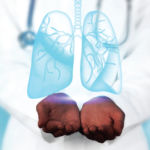“Many patients may have abnormalities on a CT scan, but may not develop symptoms and/or significant impairment,” he says. “We don’t want to overscreen individuals, but we do want to identify those with progressive disease early to intervene in diseases, such as [RA], scleroderma or polymyositis, to institute the appropriate care and identify the therapies.” Lung symptoms are particularly crucial to evaluate because they can contribute to earlier mortality, he says.
One challenge is that lungs are not well studied in rheumatic conditions, says Aryeh Fischer, MD, chief, Division of Rheumatology, co-director, the Autoimmune Lung Center, and associate professor of medicine, National Jewish Health and University of Colorado–Denver. This is despite numerous trials related to conditions, such as RA. “We need to get more organized to study this across both specialties,” he says.
The questions regarding the effects of lung disease in RA and related conditions have only emerged in the past 10 to 15 years because treatment for RA was previously so difficult, Dr. Cosgrove says. “One of the advantages with new medications for arthritis is that patients are doing well and staying active, but then they can still have lung problems. That’s something we have to address.”
The situation can be complicated by the possible presence of coronary disease, in which specialists must tease out the presence of lung or heart conditions—or both.
The situation is also complicated by the lack of studies to define effective therapies in lung disease with an underlying rheumatic disease, Dr. Cosgrove says.
One day, it would be helpful to have an algorithm that calls for a pulmonary evaluation if a patient has had RA for a certain number of years—even if they don’t have lung symptoms—and they have a certain serological marker on a blood test, Dr. Cosgrove says. However, he realizes there is a need to avoid causing anxiety among patients by ordering screens that may not be necessary.
Take-Home Suggestions
Patients should be referred to pulmonologists for any chronic lung-related symptoms—anything that is beyond a standard cold, Dr. Cosgrove says. “The harder question is when to look for potential problems that may be under the radar if patients don’t have symptoms and are well controlled on therapy,” he says.
One way that rheumatologists and pulmonologists can work together more closely to catch serious disease is by working under an organizational system that encourages cross-collaboration, says Dr. Fischer, who often collaborates with Dr. Cosgrove. “We try to break down interdisciplinary divisions at our institution. We’re not siloed. Sometimes, our patients don’t remember who is the rheumatologist and who is the pulmonologist,” he says.


